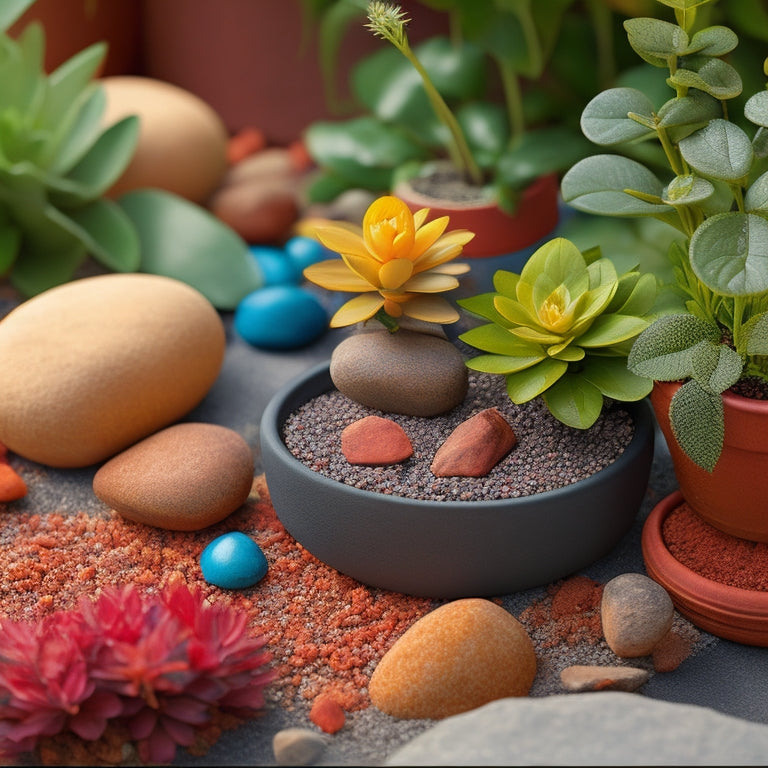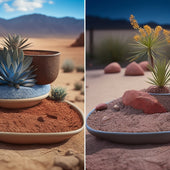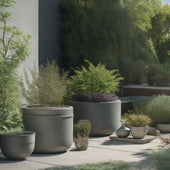
5 Simple Drainage Tips for Block Planters Beginners
Share
When creating a block planter, you'll want to choose the right cinder blocks, selecting ones with high compressive strength, density, and low water absorption. Add a layer of coarse gravel like pea gravel or decomposed granite to enhance drainage. Drill holes in the blocks, spacing them 1-2 inches apart, and consider using a drainage fabric liner to prevent soil clogging. Monitor your watering habits closely, checking soil moisture daily and adjusting your schedule accordingly. By following these simple tips, you'll be well on your way to creating a healthy environment for your plants, and with a few more expert strategies, you can guarantee your block planter thrives.
Key Takeaways
• Select dense and heavy cinder blocks with low water absorption rate (5-10%) for better moisture retention and support.
• Add a 1-2 inch layer of coarse, porous gravel like pea gravel or decomposed granite for effective drainage.
• Drill drainage holes in blocks, spacing them 1-2 inches apart, with hole size consideration based on plant type and size.
• Line the planter with a high-permeability drainage fabric to prevent soil clogging and ensure efficient water flow.
• Monitor watering habits closely, checking soil moisture daily and adjusting frequency based on seasonal needs and plant types.
Choose the Right Cinder Blocks
Select cinder blocks with a high compressive strength, typically above 1,500 pounds per square inch (psi), to confirm they can support the weight of the soil, plants, and water in your block planter. This is vital to guarantee the structural integrity of your planter.
You'll want to choose blocks that are dense and heavy, as they'll provide better moisture retention and support for the soil and plants. Look for blocks with a low water absorption rate, usually around 5-10%, to prevent water from seeping into the blocks and causing damage.
When selecting block types, consider the specific needs of your plants. For example, if you're planning to grow plants that thrive in well-draining soil, such as succulents, you may want to opt for blocks with larger pores to allow for better drainage.
On the other hand, if you're growing plants that prefer moist soil, such as ferns, you may want to choose blocks with smaller pores to retain more moisture.
Add a Layer of Gravel
After choosing the right cinder blocks, you'll want to add a layer of gravel at the bottom of your planter to facilitate drainage and prevent waterlogged soil. This layer will allow excess water to flow out of the planter, reducing the risk of root rot and other issues.
When selecting a gravel type, opt for a coarse, porous material like pea gravel or decomposed granite. These gravels have larger particles that allow for better water flow and aeration. Aim for a layer about 1-2 inches deep, depending on the size of your planter. This will provide ample space for water to drain without taking up too much room from your soil.
The drainage benefits of a gravel layer are twofold: it prevents water from accumulating in the soil and allows oxygen to reach the roots, promoting healthy plant growth. By incorporating a gravel layer, you'll create a well-draining environment that will support the health and vigor of your plants.
Create Drainage Holes Correctly
To guarantee effective drainage, drill holes in the bottom and sides of the cinder blocks, spacing them about 1-2 inches apart to create a network of escape routes for excess water. This allows water to escape quickly, reducing the risk of waterlogged soil and root rot. When it comes to drainage hole placement, take into account the type of plants you're growing. For plants that prefer well-draining soil, like succulents, you can space holes closer together. For plants that prefer moister soil, like ferns, you can space them farther apart.
| Hole Size Considerations | Why It Matters |
|---|---|
| 1/4 inch holes | Suitable for small plants, allows for slow drainage |
| 1/2 inch holes | Ideal for medium-sized plants, balances drainage and water retention |
| 3/4 inch holes | Best for large plants, allows for rapid drainage |
| More holes, less space | Increases drainage speed, but may compromise structural integrity |
| Fewer holes, more space | Slows drainage, but provides more stability |
Remember to take into account the size and type of your plants when deciding on hole size and placement. By doing so, you'll create an effective drainage system that meets the unique needs of your plants.
Use a Drainage Fabric Liner
By lining your block planter with a drainage fabric, you'll prevent soil and debris from clogging the drainage holes, ensuring that excess water can flow freely and efficiently. This is one of the most effective drainage fabric benefits, as it prevents waterlogged soil and root rot.
When selecting fabric types, consider the following factors: permeability, durability, and UV resistance. Look for fabrics with high permeability to allow for efficient water flow, and durable materials that can withstand outdoor conditions. UV resistance is vital to prevent fabric degradation over time.
When installing the drainage fabric, cut it to size and place it at the bottom of the planter, ensuring it covers the entire surface. Secure it with landscape pins or weights to prevent it from shifting. Make sure the fabric isn't too thick, as this can impede water flow. A good rule of thumb is to choose a fabric with a thickness of around 1-2 mm.
Monitor Watering Habits Closely
Pay close attention to your watering schedule, as overwatering can quickly undo the benefits of a well-designed drainage system in your block planter.
You'll want to strike a balance between keeping your plants hydrated and avoiding waterlogged soil. Check the soil moisture daily, especially during hot or dry weather, and adjust your watering frequency accordingly. If you're unsure, start with a conservative approach and gradually increase watering as needed.
It's essential to evaluate the moisture retention properties of your potting mix and plants. Some plants are more drought-tolerant than others, and certain potting mixes retain more moisture than others.
Be mindful of these factors when determining your watering schedule. You may need to water more frequently in the summer months or during periods of high wind, as the plants may dry out quickly.
Frequently Asked Questions
Can I Use Regular Potting Soil in My Block Planter?
You're wondering if regular potting soil will cut it in your block planter. The short answer is no.
Regular potting soil can retain too much water, causing root rot and poor drainage. Instead, consider potting soil alternatives specifically designed for containers, which allow for better aeration and moisture control.
You can also implement drainage solutions like adding perlite or vermiculite to improve soil structure and prevent waterlogging.
How Often Should I Repot My Plants in Block Planters?
Imagine your plants as athletes, constantly training to reach new heights.
As they grow, they'll outcompete their potting soil, depleting its nutrients. You'll need to repot them regularly to provide fresh resources.
For most plants, repotting every 1-2 years is ideal, but this frequency depends on their growth rate. Fast-growing plants might need more frequent repotting, while slow-growing ones can go longer.
Monitor your plants' progress and adjust your repotting schedule accordingly.
Will Drainage Holes Affect the Structural Integrity of My Planter?
When you add drainage holes to your planter, you're likely wondering if they'll compromise its structural integrity.
The good news is that, with proper drainage hole design, the risk of planter stability concerns is minimal.
Can I Use a Single Large Drainage Hole Instead of Multiple Small Ones?
When deciding on drainage hole placement, you're wondering if one large hole is better than multiple small ones.
While a single large hole may seem efficient, it can compromise drainage efficiency. Water may not flow out quickly enough, causing waterlogging.
Instead, use multiple small holes to increase the total hole area, allowing for faster water exit.
Opt for hole sizes around 1-2 cm in diameter to strike a balance between drainage efficiency and hole size.
Do I Need to Seal the Cinder Blocks for Outdoor Use?
As you venture into the world of outdoor planting, you'll need to make certain your cinder blocks are ready for the elements.
Don't be like the ancient Egyptians, who built pyramids that withstood the test of time, but would've crumbled under modern weather conditions!
You'll need to seal those cinder blocks to assure outdoor durability.
Apply a waterproofing agent to protect them from moisture and freeze-thaw cycles, making sure your planters remain sturdy and your plants thrive.
Conclusion
You've made it to the end of this drainage guide for block planters!
By following these simple tips, you'll be well on your way to creating a thriving oasis.
Remember, 'an ounce of prevention is worth a pound of cure' - a little extra effort upfront will save you from a world of waterlogged woes down the line.
With your new drainage know-how, get planting and enjoy the fruits of your labor!
Related Posts
-

Preventing Soil Settlement in DIY Planters
To prevent soil settlement in your DIY planters, you'll want to focus on selecting a well-balanced soil mix with good...
-

Preventing Soil Settlement in DIY Planters
To prevent soil settlement in your DIY planters, you'll want to focus on selecting a well-balanced soil mix with good...
-

Preventing Soil Settlement in DIY Planters
To prevent soil settlement in your DIY planters, you'll want to focus on selecting a well-balanced soil mix with good...
-

Preventing Soil Settlement in DIY Planters
To prevent soil settlement in your DIY planters, you'll want to focus on selecting a well-balanced soil mix with good...
-

Preventing Soil Settlement in DIY Planters
To prevent soil settlement in your DIY planters, you'll want to focus on selecting a well-balanced soil mix with good...
-

Preventing Soil Settlement in DIY Planters
To prevent soil settlement in your DIY planters, you'll want to focus on selecting a well-balanced soil mix with good...
-

Preventing Soil Settlement in DIY Planters
To prevent soil settlement in your DIY planters, you'll want to focus on selecting a well-balanced soil mix with good...
-

Preventing Soil Settlement in DIY Planters
To prevent soil settlement in your DIY planters, you'll want to focus on selecting a well-balanced soil mix with good...
-

Preventing Soil Settlement in DIY Planters
To prevent soil settlement in your DIY planters, you'll want to focus on selecting a well-balanced soil mix with good...
-

Preventing Soil Settlement in DIY Planters
To prevent soil settlement in your DIY planters, you'll want to focus on selecting a well-balanced soil mix with good...
-

Preventing Soil Settlement in DIY Planters
To prevent soil settlement in your DIY planters, you'll want to focus on selecting a well-balanced soil mix with good...
-

Preventing Soil Settlement in DIY Planters
To prevent soil settlement in your DIY planters, you'll want to focus on selecting a well-balanced soil mix with good...
-

Preventing Soil Settlement in DIY Planters
To prevent soil settlement in your DIY planters, you'll want to focus on selecting a well-balanced soil mix with good...
-

Preventing Soil Settlement in DIY Planters
To prevent soil settlement in your DIY planters, you'll want to focus on selecting a well-balanced soil mix with good...
-

Preventing Soil Settlement in DIY Planters
To prevent soil settlement in your DIY planters, you'll want to focus on selecting a well-balanced soil mix with good...
-

Preventing Soil Settlement in DIY Planters
To prevent soil settlement in your DIY planters, you'll want to focus on selecting a well-balanced soil mix with good...
-

Preventing Soil Settlement in DIY Planters
To prevent soil settlement in your DIY planters, you'll want to focus on selecting a well-balanced soil mix with good...
-

Preventing Soil Settlement in DIY Planters
To prevent soil settlement in your DIY planters, you'll want to focus on selecting a well-balanced soil mix with good...
-

Preventing Soil Settlement in DIY Planters
To prevent soil settlement in your DIY planters, you'll want to focus on selecting a well-balanced soil mix with good...
-

Preventing Soil Settlement in DIY Planters
To prevent soil settlement in your DIY planters, you'll want to focus on selecting a well-balanced soil mix with good...
-

Preventing Soil Settlement in DIY Planters
To prevent soil settlement in your DIY planters, you'll want to focus on selecting a well-balanced soil mix with good...
-

Preventing Soil Settlement in DIY Planters
To prevent soil settlement in your DIY planters, you'll want to focus on selecting a well-balanced soil mix with good...
-

Preventing Soil Settlement in DIY Planters
To prevent soil settlement in your DIY planters, you'll want to focus on selecting a well-balanced soil mix with good...
-

Preventing Soil Settlement in DIY Planters
To prevent soil settlement in your DIY planters, you'll want to focus on selecting a well-balanced soil mix with good...
-

Accurate Measuring for DIY Block Planters Made Easy
As you begin building a DIY block planter, precise measurement is essential for a sturdy structure that can support s...
-

Accurate Measuring for DIY Block Planters Made Easy
As you begin building a DIY block planter, precise measurement is essential for a sturdy structure that can support s...
-

Accurate Measuring for DIY Block Planters Made Easy
As you begin building a DIY block planter, precise measurement is essential for a sturdy structure that can support s...
-

Accurate Measuring for DIY Block Planters Made Easy
As you begin building a DIY block planter, precise measurement is essential for a sturdy structure that can support s...
-

Accurate Measuring for DIY Block Planters Made Easy
As you begin building a DIY block planter, precise measurement is essential for a sturdy structure that can support s...
-

Accurate Measuring for DIY Block Planters Made Easy
As you begin building a DIY block planter, precise measurement is essential for a sturdy structure that can support s...
-

Accurate Measuring for DIY Block Planters Made Easy
As you begin building a DIY block planter, precise measurement is essential for a sturdy structure that can support s...
-

Accurate Measuring for DIY Block Planters Made Easy
As you begin building a DIY block planter, precise measurement is essential for a sturdy structure that can support s...
-

Accurate Measuring for DIY Block Planters Made Easy
As you begin building a DIY block planter, precise measurement is essential for a sturdy structure that can support s...
-

Accurate Measuring for DIY Block Planters Made Easy
As you begin building a DIY block planter, precise measurement is essential for a sturdy structure that can support s...
-

Accurate Measuring for DIY Block Planters Made Easy
As you begin building a DIY block planter, precise measurement is essential for a sturdy structure that can support s...
-

Accurate Measuring for DIY Block Planters Made Easy
As you begin building a DIY block planter, precise measurement is essential for a sturdy structure that can support s...
-

Accurate Measuring for DIY Block Planters Made Easy
As you begin building a DIY block planter, precise measurement is essential for a sturdy structure that can support s...
-

Accurate Measuring for DIY Block Planters Made Easy
As you begin building a DIY block planter, precise measurement is essential for a sturdy structure that can support s...
-

Accurate Measuring for DIY Block Planters Made Easy
As you begin building a DIY block planter, precise measurement is essential for a sturdy structure that can support s...
-

Accurate Measuring for DIY Block Planters Made Easy
As you begin building a DIY block planter, precise measurement is essential for a sturdy structure that can support s...
-

Accurate Measuring for DIY Block Planters Made Easy
As you begin building a DIY block planter, precise measurement is essential for a sturdy structure that can support s...
-

Accurate Measuring for DIY Block Planters Made Easy
As you begin building a DIY block planter, precise measurement is essential for a sturdy structure that can support s...
-

Accurate Measuring for DIY Block Planters Made Easy
As you begin building a DIY block planter, precise measurement is essential for a sturdy structure that can support s...
-

Accurate Measuring for DIY Block Planters Made Easy
As you begin building a DIY block planter, precise measurement is essential for a sturdy structure that can support s...
-

Accurate Measuring for DIY Block Planters Made Easy
As you begin building a DIY block planter, precise measurement is essential for a sturdy structure that can support s...
-

Accurate Measuring for DIY Block Planters Made Easy
As you begin building a DIY block planter, precise measurement is essential for a sturdy structure that can support s...
-

Accurate Measuring for DIY Block Planters Made Easy
As you begin building a DIY block planter, precise measurement is essential for a sturdy structure that can support s...
-

Accurate Measuring for DIY Block Planters Made Easy
As you begin building a DIY block planter, precise measurement is essential for a sturdy structure that can support s...
-

Accurate Measuring for DIY Block Planters Made Easy
As you begin building a DIY block planter, precise measurement is essential for a sturdy structure that can support s...
-

Accurate Measuring for DIY Block Planters Made Easy
As you begin building a DIY block planter, precise measurement is essential for a sturdy structure that can support s...
-

Accurate Measuring for DIY Block Planters Made Easy
As you begin building a DIY block planter, precise measurement is essential for a sturdy structure that can support s...
-

Summer Care Tips for Concrete Planters
As you step into the warmest season of the year, your concrete planters require deliberate care to thrive. Clean your...
-

Summer Care Tips for Concrete Planters
As you step into the warmest season of the year, your concrete planters require deliberate care to thrive. Clean your...
-

Summer Care Tips for Concrete Planters
As you step into the warmest season of the year, your concrete planters require deliberate care to thrive. Clean your...
-

Summer Care Tips for Concrete Planters
As you step into the warmest season of the year, your concrete planters require deliberate care to thrive. Clean your...
-

Summer Care Tips for Concrete Planters
As you step into the warmest season of the year, your concrete planters require deliberate care to thrive. Clean your...
-

Summer Care Tips for Concrete Planters
As you step into the warmest season of the year, your concrete planters require deliberate care to thrive. Clean your...
-

Summer Care Tips for Concrete Planters
As you step into the warmest season of the year, your concrete planters require deliberate care to thrive. Clean your...
-

Summer Care Tips for Concrete Planters
As you step into the warmest season of the year, your concrete planters require deliberate care to thrive. Clean your...
-

Summer Care Tips for Concrete Planters
As you step into the warmest season of the year, your concrete planters require deliberate care to thrive. Clean your...
-

Summer Care Tips for Concrete Planters
As you step into the warmest season of the year, your concrete planters require deliberate care to thrive. Clean your...
-

Summer Care Tips for Concrete Planters
As you step into the warmest season of the year, your concrete planters require deliberate care to thrive. Clean your...
-

Summer Care Tips for Concrete Planters
As you step into the warmest season of the year, your concrete planters require deliberate care to thrive. Clean your...
-

Summer Care Tips for Concrete Planters
As you step into the warmest season of the year, your concrete planters require deliberate care to thrive. Clean your...
-

Summer Care Tips for Concrete Planters
As you step into the warmest season of the year, your concrete planters require deliberate care to thrive. Clean your...
-

Summer Care Tips for Concrete Planters
As you step into the warmest season of the year, your concrete planters require deliberate care to thrive. Clean your...
-

Summer Care Tips for Concrete Planters
As you step into the warmest season of the year, your concrete planters require deliberate care to thrive. Clean your...
-

Summer Care Tips for Concrete Planters
As you step into the warmest season of the year, your concrete planters require deliberate care to thrive. Clean your...
-

Summer Care Tips for Concrete Planters
As you step into the warmest season of the year, your concrete planters require deliberate care to thrive. Clean your...
-

Summer Care Tips for Concrete Planters
As you step into the warmest season of the year, your concrete planters require deliberate care to thrive. Clean your...
-

Summer Care Tips for Concrete Planters
As you step into the warmest season of the year, your concrete planters require deliberate care to thrive. Clean your...
-

Summer Care Tips for Concrete Planters
As you step into the warmest season of the year, your concrete planters require deliberate care to thrive. Clean your...
-

Summer Care Tips for Concrete Planters
As you step into the warmest season of the year, your concrete planters require deliberate care to thrive. Clean your...
-

Summer Care Tips for Concrete Planters
As you step into the warmest season of the year, your concrete planters require deliberate care to thrive. Clean your...
-

Summer Care Tips for Concrete Planters
As you step into the warmest season of the year, your concrete planters require deliberate care to thrive. Clean your...
-

Summer Care Tips for Concrete Planters
As you step into the warmest season of the year, your concrete planters require deliberate care to thrive. Clean your...
-

Summer Care Tips for Concrete Planters
As you step into the warmest season of the year, your concrete planters require deliberate care to thrive. Clean your...
-

Summer Care Tips for Concrete Planters
As you step into the warmest season of the year, your concrete planters require deliberate care to thrive. Clean your...
-

Summer Care Tips for Concrete Planters
As you step into the warmest season of the year, your concrete planters require deliberate care to thrive. Clean your...
-

Summer Care Tips for Concrete Planters
As you step into the warmest season of the year, your concrete planters require deliberate care to thrive. Clean your...


